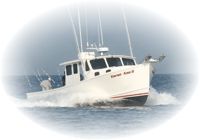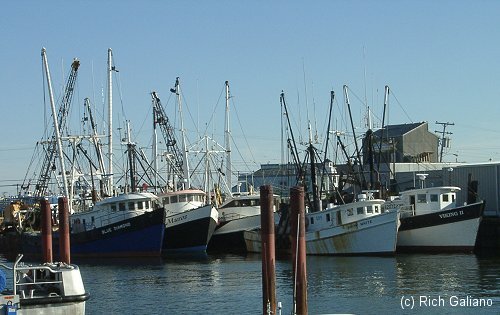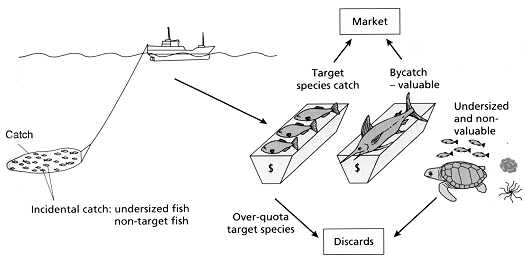Fisheries Management Primer
by Captain Adam Nowalsky
copied from charter boat Karen Ann II

As a charter boat operator, it is my job to ensure that my fares adhere to the current fishing regulations. While the current regulations are posted on my website for passengers to see, many people show up not knowing beforehand what the regulations are, and in some cases, that regulations even exist. This is likely because the fisheries management process can be difficult to understand, resulting in very few people getting involved. Hopefully, this article can help de-mystify the process.
History
In 1976, the United States authorized the Magnuson Fishery Conservation and Management Act ( renamed the Magnuson-Stevens Fishery Conservation and Management Act, or MSFCMA, in 1996 ), providing for federal management of the US Exclusive Economic Zone (EEZ) out to 200 miles from our coasts. As an act of living legislation, the MSFCMA evolved to authorize not only Foreign Fishing and International Fishery Agreements, but also National Fishery Management and Fishery Monitoring and Research. Authority rested with the Department of Commerce through NOAA Fisheries and eight Regional Fishery Management Councils.
In 1996, the Magnuson-Stevens Act was re-authorized and further strengthened by the passage of the Sustainable Fisheries Act (SFA). Greater emphasis was placed on fisheries management to rebuild over-fished stocks, reduce the amount of fish caught unintentionally and discarded, protect fish habitats, prevent over-fishing of our nation's fishery resources, and minimize adverse economic impacts on fishing communities. On June 27, 2003, the United States Department of Commerce announced the Bush Administration's Reauthorization Bill 2003 to further strengthen the Magnuson-Stevens Act.
Organization
Today, NOAA Fisheries ( formerly known as the National Marine Fisheries Service, or NMFS ) is "dedicated to the stewardship of living marine resources through science-based conservation and management, and the promotion of healthy ecosystems". In addition to sustaining fisheries, NOAA Fisheries must also protect all marine species including mammals, shellfish, and corals, conserve marine habitat, ensure a sound scientific basis for conservation and management decisions and provide for law enforcement. While sustaining fisheries also includes Highly Migratory Species ( tuna, sharks, swordfish, and billfish ), this article mainly discusses the management of domestic fisheries.
For domestic fisheries management, NOAA Fisheries utilizes the following Councils, Commissions and Offices/Centers -
- Eight Regional Fishery Management Councils, which manage the living marine resources within that area for the EEZ (from 3-200 nautical miles offshore), including development of Fishery Management Plans (FMPs). NJ has 2 appointed voting members as well as a pair of designated state officials on our regional council, the Mid-Atlantic Fishery Management Council (MAFMC).
- Three Interstate Marine Fishery Commissions, which manage and conserve shared coastal fisheries within the first 3 miles of the nation's coastline. For those species that have significant fisheries in both state and federal waters, the Commission works cooperatively with the relevant Regional Fishery Management Council. NJ is a member of the Atlantic States Marine Fisheries Commission (ASMFC).
Each coastal state has its own organization which is responsible for setting state regulations that are in compliance with the federally mandated regulations set by the appropriate NOAA Fisheries body outlined above. Here in New Jersey, the Marine Fisheries Council (NJ MFC) is required to set state regulations which comply with regulations set forth by the MAFMC and ASMFC.

The Process
Now that we know who sets the regulations, the next issue is how they set the regulations. There are a number of technical terms that go into the development of a Fishery Management Plan (FMP), with terms like MSY ( maximum sustainable yield ), SSB ( spawning stock biomass ), TAC (total allowable catch) and mortality rate coming to mind. The end result is that a quota is established (usually by weight) which dictates the targeted catch for all gear types (both commercial and recreational) on a given species. When the reported catch for a given species exceeds the allowable catch, quota reductions result by way of increased size limits, reduced bag limits, and shortened seasons. ( Scientists have complex formulas for each species that dictate how different combinations of the above factors equate to the weight of landings. ) the process seems logical enough, but a number of issues have arisen, specifically Allocation, Stock Size and Landings.
Allocation - At issue is the allocation (division) of the total quota not only between recreational and commercial interests but also between states. Recreational anglers clamor for higher quotas on the basis of greater numbers and the dollars they inject into the company through boat sales/rentals, bait and tackle sales, fuel sales, food sales, etc. The commercial sector claims higher quotas on the premise that they are meeting a larger demand (both anglers and non-anglers) for fish through restaurants and fish markets, plus their own economic contributions of vessel costs, fuel sales, etc. A state like NY may argue a higher quota based on an overall higher population as compared to NJ, who in turn argues that a greater percentage of the population lives within 50 miles of the coast and is, therefore, more likely to fish.
Stock Size - the methods for determining the health of a stock are constantly at issue. To be statistically valid, population samples are usually taken from the same areas. Fishermen know that fish move, and just because they aren't in the same place they were last year or last month, doesn't mean the stock isn't healthy. Other factors ( such as a period where reported landings are down due to poor weather and lack of effort as opposed to a true lack of fish ) may cause scientists to say a stock is being over-fished despite the fact that anglers are reporting excellent catches. The opposite may also be true ( samplings indicating a larger stock than there is ) which could result in true over-fishing and damaging the stocks for the future. The strengthening of fishery management laws and the pressure from organized environmental groups puts tremendous political pressure on fisheries management officials to keep a stock from becoming over-fished, which may result in lower stock size estimates "to be on the safe side".
Landings - Perhaps the biggest point of contention, particularly with the recreational sector, is assessing reported landings and fishing effort. Since all commercial fishermen are supposed to have permits and report their catch on a near-daily basis, regulators have the ability to shut down a fishery when they believe the allowable catch for a given period is about to be reached. Recreational fishermen have no such system; instead, the Marine Recreational Fisheries Statistics Survey (MRFSS) data has been used to estimate recreational landings. Reported in 2-month "waves", the MRFSS data takes in excess of 6 months to compile as opposed to the near "real-time" status of commercial landings reports. Surveyors use a combination of random phone samplings in addition to "dockside intercepts" to gather data, with a very small ( less than 1% ) portion of the fishing public being sampled. The sample is then multiplied by what is believed to be the fishing effort, with the result being the landings estimate; the sampling does not take into account the actual validity of the information gathered.
For example, dockside intercepts and phone interviews done over a given week in June may say X pounds of fish were caught by 1% of the recreational fishing population. Scientists then multiply this number by 100 to estimate the total pounds of fish caught by everyone (100%), and will then multiply this result by 4 (number of weeks in the month), with the result of X x 100 x 4 being the landings for the month of June. If those sampled had exceptionally good fishing days and the weather for the rest of the month was crappy, this estimate can be nowhere near close to the actual landings. The result - even though we are adhering to the regulations established for us, we are WAY over-fishing the stock ( through no fault of our own since we are just following the regulations. )

Simply put, this system was never intended to provide true landings data, but rather to provide general trends of landings over a period of time. As the pressure from legislation to reduce over-fishing has increased, regulators had to use something, and MRFSS was one of the only available pieces of "statistically valid" data available on a coast-wide basis. It has proven itself to be completely unreliable as a landings estimation tool. ( Here on the East Coast, a new program is in the works, the Atlantic Coastal Cooperative Statistics Program, or ACCSP, including For-Hire Surveys for party and charter boat captains, who account for significant landings in the recreational sector. )
Despite the shortcomings, technical committees within the Regional Councils and Commissions must set quotas that they believe will keep a given species from being over-fished based on the "best available science". These quotas are then allocated to the commercial and recreational sectors within each state. The technical committees also provide guidance as to what combination of size, bag and seasons will achieve the desired landings. It is then up to the individual states to approve these regulations within their own states. With some species, like with Summer Flounder, states have the ability to apply "conservation equivalencies", or comparable size, bag, and seasons that will result in the desired landings. ( For example, the ASMFC may suggest a 10 fish, 15" limit with a 4-month open season. If a given state wishes to extend the season to 5 months, they can use the "conservation equivalency" of, say, 8 fish at 16". ) Failure to implement approved equivalency results in the state being held "out of compliance", which could result in NMFS completely shutting down the fishery.
Public Input
In determining final state regulations, the NJ MFC holds public meetings to decide regulations. Many of these meetings are preceded by public comment periods, often with public hearings. While it is ultimately up to the Council to vote on the regulations, the public input can often go a long way towards achieving more desirable regulations. The ASMFC, MAFMC, and even NOAA Fisheries have similar public comment opportunities. In addition to attending the meetings, public comments are usually accepted via fax, e-mail, and regular mail. This is your chance to be heard and make a difference!
Fisheries management is not going away. We've seen the worst of times for many species, and hopefully, good management can help restore other species currently over-fished. While the "science" is a large problem, given time, that can hopefully be improved. NOAA Fisheries is aware of the problems and is working on improved processes. We have to thank a number of organizations for their efforts to address these issues, perhaps most notably the Recreational Fishing Alliance (RFA). The battle is far from over, however, and YOU need to be a part of the solution. So take an interest in fisheries management, because if you don't, you may one day find yourself shut out of fishing.
